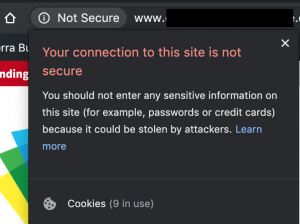SSL (Secure Sockets Layer) is the standard security technology to create secure connections to a server via the Internet. This means a secure connection from your website to the hosted server.
This is becoming very important because we use the internet for most things, from getting in touch with a supplier, selling or buying. Therefore providing your website visitors with a secure website is very important.
Providers like Google is continuing their efforts to increase the amount of secure websites on the internet. In 2018 Google started showing a green padlock icon in the address bar for the sites that is secure and showing “Not Secure” on those sites that does not have a SSL certificate installed.
Having a SSL certificate on your website can
- Increase website security by encrypting website information/data transfers
- Making it harder for hackers to capture data that is transferred in your website
- Increase brand trust of your website with secure website site seals

You can find out whether your website is secure or not by simply checking the address bar of your web browser, and it will show “Not Secure”.

So how do you make your website secure by installing a SSL Certificate
Easiest thing is to contact your existing website design agency or your website hosting provider and request them to purchase and install a SSL certificate.
You might find there are various types of SSL certificates in the market. The type of SSL you need is dependent on the website that you are managing.
• The first type of SSL certificate is a self-signed certificate. As the name implies, this is a certificate that is generated for internal purposes and is not issued by a certification authority (CA). Since the website owner generates their own certificate, it does not hold the same weight as a fully authenticated and verified SSL certificate issued by a CA. (Not Recommended)
• A Domain Validated certificate is considered an entry-level SSL certificate and can be issued quickly. The only verification check performed is to ensure that the applicant owns the domain (website address) where they plan to use the certificate. No additional checks are done to ensure that the owner of the domain is a valid business entity. (Recommended)
• A fully authenticated SSL certificate is the first step to true online security and confidence building. Taking slightly longer to issue, these certificates are only granted once the organisation passes a number of validation procedures and checks to confirm the existence of the business, the ownership of the domain, and the user’s authority to apply for the certificate. (Recommended)
We found a good beginners guide on SSL Certificates that is published by Symantec and you can find it by visiting: https://www.websecurity.symantec.com/content/dam/websitesecurity/digitalassets/desktop/pdfs/whitepaper/beginners-guide-to-SSL-certificates_WP.pdf

